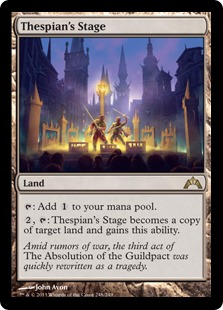Deck building in Magic is not an easy thing to accomplish, regardless of what your format of choice is. Whether you’re designing a deck for Standard, or Legacy, or EDH, the formats have different conditions on what you can – and can’t – use. These restrictions force players to be rather creative in their choice of cards to put into their decks (assuming they’re not simply copying someone else’s idea). You only have a certain number of slots available, and the decisions you make count as to whether or not it’ll work.
To that end, let’s clear up one subjective topic of the difficulties of deck building:
First, whatever your format of choice is, we need to acknowledge that other formats out there, even if they aren’t what excites you personally, provide the same degree of challenges as the ones that you do like. Whether it’s Modern or Commander, it takes time and effort to tune a deck to the way you want it to work. As Mark Rosewater often states, the game is designed with lots of different play styles in mind, and no one style is superior than the next. It’d be great if folks stopped lambasting Wizards every set because they seemingly focused too much on format X instead of what they themselves wanted.
Second, casual play is the same caliber difficulty as any constructed format. Too often I see players dismissive of casual Magic because decks aren’t tournament worthy. The vast majority of Magic games in the world exist at the casual level, and the community shouldn’t be so condescending of casual deck builds. Casual players build with what they have or can acquire cheaply. While they make like many of the sought after cards in sets, they aren’t always after the same powerful or valuable cards that other formats are. However, casual play – especially multiplayer casual – has the entire catalog of Magic cards to choose from. In an area where you can literally use any card you have, it often becomes difficult to whittle what you want to put into your decks down if you have a lot of options. When you have room for 5 cards and you have 40, it certainly provides its own challenges.
I know this from experience. Outside of EDH or draft, I pretty much play multiplayer casual exclusively. I’ve been playing for 19 years, have over 30 decks, and my average deck size is about 80 cards. My decks aren’t built for expediency, but for utility. A finely-tuned 60 card duel deck is great, but time and again I’ve seen those decks fail in games of 4+ players, or they are so precise in their one-trick efficiency that when people know what deck you’re using and shut that combo down, the deck becomes useless. So, no, I don’t see 60 cards, or required playsets of card N as cardinal rules for casual. But that provides its own problems. You want to be able to prepare yourself from multiple angles, which means a lot of planning.
One way to handle the unknown is by copying something you find pretty useful on the board. Maybe it’s a useful political deterrent, or it’s merely a means to avoid getting killed. Clone effects are pretty much a Blue-only skill though, right? If you’re not playing a deck with Blue, you’d be out of luck?
Well, not entirely. Red can copy instants & sorceries, artifacts can copy artifacts, and Green can copy tokens.
And there’s also the ability to copy . . . lands.
Yep. Lands. Today we have: Thespian’s Stage
Name: Thespian’s Stage
Edition: Gatecrash
Rarity: Rare
Focus: Copy Effects
Highlights: One of the things the Commander format is known for is non-basic land. When you only have access to 100 unique cards at any given time, you’re always looking to maximize versatility. Whether it’s mana-fixing or random abilities, non-basic lands are pretty common here.
At present, there are only two lands that have the ability to copy other lands: Thespian’s Stage and Vesuva. Both let you clone a land for your own use, and that idea is pretty self-explanatory. So, instead, let’s look at where these two cards differ.
Where Vesuva Has The Advantage:
- Speed: Vesuva doesn’t require mana to use its copy effect. This is less useful in slower formats like Commander and casual, but in more aggressive formats, having to use Thespian’s as your land drop for the turn and then pay an additional just 2 isn’t feasible.
- Use of “Enters the Battlefield” triggers: A number of lands in the modern era have seen some simple but useful enters the battlefield effects attached to lands, such as the Hideaway lands (e.g., Mosswort Bridge), the Future Sight lands (New Benalia), or the Zendikar/Worldwake lands (Bojuka Bog). Since these lands already come in tapped, Vesuva’s “enters tapped” condition isn’t a big deterrent.
Where Thespian’s Has The Advantage:
- Cost: Vesuva is used in more competitive formats, and this drives up cost. Thespian’s Stage is much, much more economical to acquire.
- Mana Production & More: In Commander, Vesuvas aren’t usually going to be used quickly if you don’t have to – it’ll be avoided on basic land if at all possible. So, sometimes that means waiting for a useful target, and sitting on playing land can stink, especially if you can use the mana. By contrast, Thespian’s Stage can be dropped turn one for mana. When something interesting does finally come around, then you can active it and copy what you want.
- Multiple Use: Thespian’s Stage retains its copy ability, so if you start off copying something mediocre and a more beneficial target comes along, you can always change it later. The 2 mana in EDH is a very minor cost.
- Avoiding Negative ETB Effects: There are positive enter the battlefield triggers that you could miss out on with the Stage. However, on the other hand you can use it to circumvent the downside of potent lands requiring you to do things like bounce or sacrifice lands. These would be cards such as the Ravnica guild lands (e.g., Boros Garrison), the Planeshift Lairs (Treva’s Ruins), Scorched Ruins, or the Alliance rares (Soldevi Excavations).
In the end, it’s apparent that Thespian’s Stage provides more versatility in Commander on most levels, but both cards will serve you well. And if you’re fortunate enough, hey, no one says you can’t use both!
Keep an eye out for us to be regularly featuring other more accessible-but-worth-it Commander cards going forward. In the meantime, we’ll keep the light on for you.
![]()
You can discuss this article over on our forums!
Do you have a particular Commander card to suggest for us to shine a future Spotlight on? You can send suggestions to ryan@cardboardrepublic.com


